As of late 2024, 78% of businesses use AI in at least one function, and 71% of businesses use specifically generative AI. These statistics both mark significant increases in AI usage since 2023, and we can confidently predict that these numbers will continue to grow in 2025 and beyond. The most popular generative AI model, ChatGPT, has remained the most powerful player as a productivity, organizational, and informational tool for businesses across industries. But how exactly are we meant to be using ChatGPT for marketing? And, more importantly, how are we doing it with the highest possible level of efficiency?
How Is ChatGPT Used in Marketing?
ChatGPT is a powerful generative AI model that can perform hundreds of unique operations. Let’s review a few of them and how they could be useful for marketers:

- Analyzing Data: ChatGPT performs the intake, analysis, and sorting of massive amounts of data, whether it be an SEO keyword report or a large paid advertising dataset.
- Generating Reports: Not only can ChatGPT analyze and sort large amounts of data, it also generates reports from said data, saving marketers the time (and the headache) of organizing data for marketing performance reporting.
- Performing Research: From identifying reliable and legitimate sources to use in your writing, to giving you frameworks for demographic insights about your customer base.
- Writing & Editing Content: When provided with a well-engineered prompt, ChatGPT can create a wide variety of marketing content, from video marketing content to blog posts, social media captions, content direction, email copy, and so much more. It can also edit said content for tone, voice, grammar, and spelling.
- Writing Code: Need a piece of custom JavaScript or CSS for your website? Ask ChatGPT, and it’ll write it for you.
- Operating as a Chatbot: OpenAI (the company behind ChatGPT) has an API that can be integrated into an app or website. This API can then be used to build out a custom chatbot that can serve as an important component of your marketing strategy.
- Giving Recommendations & Insights: Give ChatGPT an appropriate amount of context, and it can act as your brainstorming partner for marketing mix modeling and optimizing paid advertising campaigns.
- Generating Images: ChatGPT is integrated with a tool called DALL-E, a generative AI engine that is specifically designed for image generation.
Though ChatGPT is powerful, it’s not a perfect engine. I recommend that it be used by knowledgeable marketers as a “helping hand”, not as a replacement for a fully-operational marketing team.
Advantages & Disadvantages of ChatGPT for Marketing
If you’re a marketer reading this, don’t worry; ChatGPT isn’t taking your job today, tomorrow, or at any point in the near future. Marketing, at its core, is a human-focused discipline based heavily on consumer psychology. The way we see it, there will always be a human element required.
That being said, let’s look at some of the most prominent advantages and disadvantages of using ChatGPT (and generative AI in general) for marketing:
Advantages of AI & ChatGPT for Marketing
- Availability & Speed: Generative AI tools don’t log off at 5pm. They’re operational 24/7, making them invaluable for things that are needed last-minute or on a tight timeline. Need a chart for a QBR that starts in 15 minutes? Turn to ChatGPT. It won’t be perfect, but it’ll be better than showing up empty-handed.
- Efficient Data Analysis: As an SEO who has spent years poring over spreadsheets, I can personally attest that generative AI (particularly the Gemini integration in Google Sheets) is very helpful when it comes to manual tasks like data sorting and cleanup. It means I save time on keyword research and can spend more time working on the things that actually move the needle: writing high-quality, helpful content.
- Scalability & Cost-Effectiveness: This one might sound a little scary, but it’s always been about efficiency. According to McKinsey, the implementation of AI in marketing functions has the potential to result in a 10% decrease in global function spending. To my fellow marketers reading this, it’s time to start embracing AI as an extension of your (assuredly brilliant) marketing brain.
- Wide Range of Marketing Knowledge: As brilliant as your brain may be, ChatGPT and other generative AI models allow you to further extend your marketing knowledge quicker than ever before. You can talk to it at your level; no more dumbing down your asks to search for answers with traditional Google searches.
Disadvantages of AI & ChatGPT for Marketing
- Shortage of In-Depth, Contextual & Industry Expertise: This is a great example of the human element of marketing. While ChatGPT is great at doing things fast, it doesn’t have the kind of understanding that comes from having years of industry experience. The content it writes can miss the mark in terms of context, trends, recent industry updates, and hyper-specialized language.
- Absence of Emotional Intelligence: ChatGPT doesn’t feel emotions or have malleable neural pathways like we do, making it harder to capture things like empathy, irony, or nuanced humor that connects deeply with audiences. I actually asked ChatGPT to draft this section for me, and it didn’t even get offended. A human (or at least I) would have.
- Dependency on Data Quality: The outputs that generative AI spits out are only as strong as the data they’re given. If data is outdated, incomplete, or biased, you better believe that the output will be, too. In this instance, human oversight is definitely still essential to ensure accuracy and relevance.
- Information Bias & Security Risks: On a similar note to the data quality point, ChatGPT can (and will) reproduce any biases present in both your data and its own training data. Additionally, using generative AI sometimes involves sharing proprietary information, which introduces potential privacy and data security risks.
- Lack of Human Creativity: ChatGPT is great at remixing existing ideas, but struggles to invent truly original concepts, especially when the goal is to be bold or unconventional. Human marketers (that’s us!) bring intuition, cultural awareness, and out-of-the-box thinking that AI can’t replicate.
Which AI Model Is Best for Marketing?
We’ve focused mainly on ChatGPT up to this point, but it’s a fact that not every generative AI model is created equally. Some models excel at certain marketing and marketing-adjacent functions, while others fall a little short. Here’s a diagram to give you an idea of which generative AI you should be using depending on your needs.

One word of caution: don’t take the above as the final say. The information provided is based on our own experimentation with generative AI.
There are other factors at play when deciding which model is right for you; things like your industry, the specific marketing function you operate in, how well-engineered your prompts are, and more.
Can ChatGPT Do Digital Marketing?
Alright—now you know the things that ChatGPT can do, its advantages and disadvantages, and what other generative AI models are available to you. It’s now time to drill down into specific marketing functions and go over all of the ways ChatGPT can help improve your efficiency and productivity. And for another added bit of reassurance, remember, the goal is not for AI to take your job, it’s for AI to help make you BETTER at your job.
Digital marketing is a broad space, and AI has a place in almost every discipline within it. In this post, I’ll be focusing on SEO (I’m no ChatGPT, but I guess I am a little biased after all), paid search, and social media marketing. If you’re looking for something specific to video marketing, we’ve got an article for you right here.
As a bonus, at the end I’ll also be giving away a few super duper helpful tips for marketing prompt engineering 😉
How to Use ChatGPT for SEO
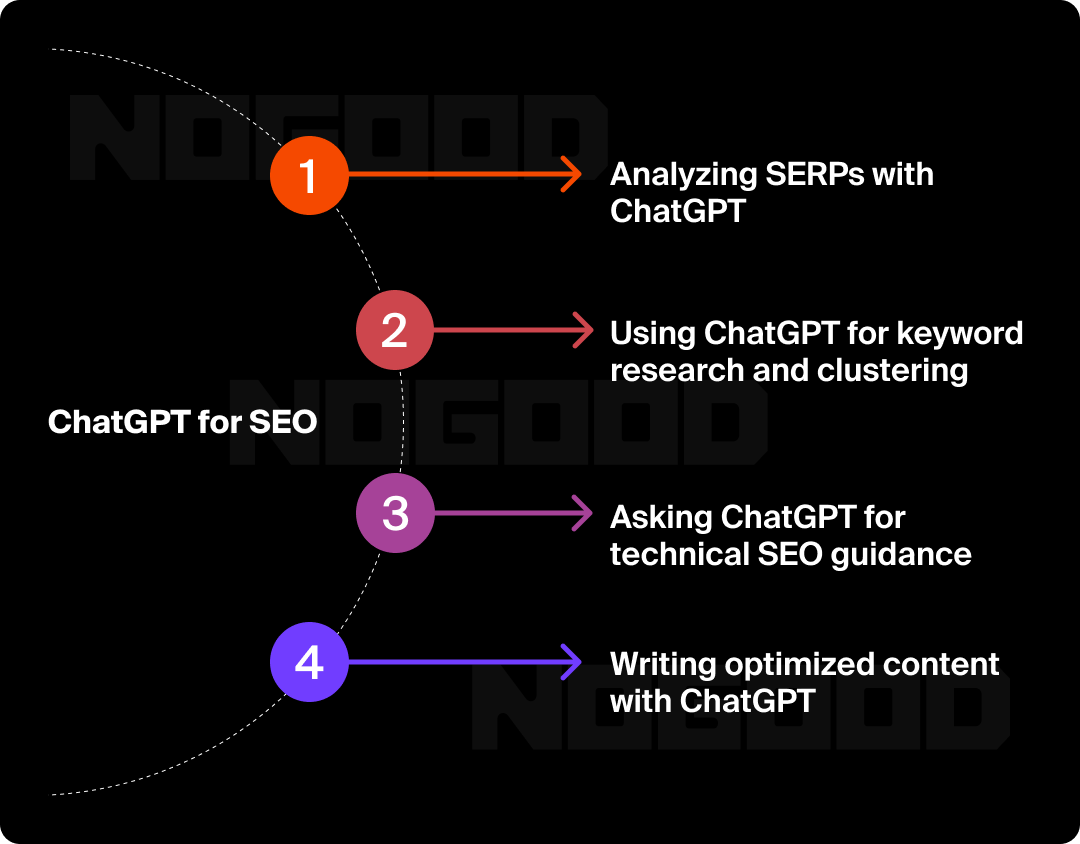
As an SEO myself, the four main ways I use ChatGPT for SEO are:
- Analyzing SERPs with ChatGPT
- Using ChatGPT for keyword research and clustering
- Asking ChatGPT for technical SEO guidance
- Writing optimized content with ChatGPT
1. Analyzing SERPs With ChatGPT
When creating content to rank well in search engines, researching what’s already ranking and implementing a sort of “drafting” strategy is a common tactic that works.
To analyze a SERP with ChatGPT, you can either use one of the prompts provided below or leverage a ChatGPT model like SERP Analyser Pro. This is a model specifically trained for this function, eliminating the need to “mini-train” your own model.
The added benefit of this model is that it also takes into account newer disciplines of search optimization, like Answer Engine Optimization (or AEO; it’s also called GEO, LLMO, and AI Search. The SEO world clearly hasn’t landed on a name yet, but we are working on it, I promise).
Speaking of SERP analysis tools, and before we get into some example prompts, I also feel the need to give credit where credit is due: a non-ChatGPT-powered tool that I love to use for AI SERP analysis is Frase.io.
SERP Analysis Prompts for ChatGPT
Depending on your goal with SERP analysis, there are a few options for ChatGPT prompts you can use:
- For SERP Content & Intent Analysis: “Analyze the top 10 Google results for [keyword]. Identify the dominant content types (blog, product page, video, etc.), the search intent (informational, navigational, transactional, commercial), and summarize what the top pages focus on.”
- For Content Gap & Opportunity Identification: “Compare the common topics, angles, or subtopics covered in the top-ranking pages for [keyword] and tell me what’s missing that I could cover to stand out.”
- For Featured Snippets & Rich Results: “Look at the SERP for [keyword] and describe any Featured Snippets, People Also Ask results, or other SERP features. Suggest how I might optimize to target these.”
- For General Content Length & Format: “For the top-ranking pages on [keyword], tell me the common content formats and average content length.”
2. Using ChatGPT for Keyword Research & Clustering
Along with SERP analysis, keyword research, and clustering are foundational elements of SEO, but they’re very data-heavy. With ChatGPT, gone are the days of sifting through massive spreadsheets, parsing the data manually (as much as I loved doing it, I can admit that using ChatGPT has saved me a lot of time and headaches).
The way I use ChatGPT for keyword research is to uncover variations of keywords within clusters or topics that I’ve already identified. You’ll notice a trend where I like to start with human analysis and then use ChatGPT to refine my keyword strategy.
Keep this in mind: the goal of keyword research and clustering is to have a clear direction and justification for an intentional SEO strategy. However, be sure to also incorporate other SEO tools (shouting out Ahrefs for this one) that give you accurate information on search volume and keyword difficulty for your keywords.
Let’s look at a few ChatGPT prompts for keyword research and clustering.
Keyword Research & Clustering Prompts for ChatGPT
For Clustering Keywords by Topic or Intent:
- “Take the below list of keywords and group them by search intent (informational, transactional, navigational, commercial)” and paste the list.
- “Cluster the below keywords into topic clusters or content pillars for a blog strategy,” and paste the list.
- “Group the below keywords by theme so that each group could be covered by a single comprehensive page or article,” and paste the list.
For Discovering Variations of Keywords:
- “Generate a list of related keywords and long-tail variations for [main keyword] that people might search for.”
- “What questions do people ask about [topic] that could be used as blog post titles or FAQ content?”
- “Find semantically related terms and synonyms for [keyword] that could help expand topical coverage.”
Build Keyword Lists for Specific Audiences or Use Cases:
- “Create separate keyword lists targeting beginners vs. advanced audiences interested in [topic].”
- “Generate keywords that combine [main topic] with purchase-related modifiers like “best”,”buy”,”reviews”, and “pricing”.”
3. Asking ChatGPT for Technical SEO Guidance
I’ll be the first to admit that I am not a technical SEO expert or a web developer by trade. That being said, I’ve found ChatGPT to be an extremely helpful starting point in terms of general recommendations and best practices when it comes to improving a website’s technical SEO performance.
For the sake of continuing the trend of non-ChatGPT tool recommendations, I’ve decided that my winners for technical SEO are Screaming Frog and PageSpeed Insights.
Technical SEO Prompts for ChatGPT
Similar to SERP analysis, the prompts you can give ChatGPT for technical SEO will vary depending on your goal:
- For Audit Data Interpretation: “Here’s a crawl report export from [crawl platform]. Can you help me interpret the data? Tell me what the most important issues are, group them by priority, and explain why they matter.”
- For Site Content Structure: “Here’s a list of my site’s top pages by traffic and topic. Can you identify which could be pillar pages and suggest related cluster topics or supporting content?”
- For Crawlability & Indexability: “Here’s a list of my website’s URLs and their current index status. Can you review and tell me which pages should be indexed and which might be better left out and why?”
- For Fix Recommendations: “Here’s a PageSpeed Insights report. Can you summarize the main performance issues and list practical fixes we could try to correct?”
- For Structured Data Insights: “Here’s a list of page types on my site (blog posts, landing pages, product pages, etc.). Can you recommend the most relevant structured data types for each?”
As you’ll notice, many of these prompts require you to have an export of your site’s pages, a technical SEO report, or a Core Web Vitals report on hand. Getting this report into a format that is readable by ChatGPT is still a manual process, but an incredibly manageable task given that ChatGPT is doing the heavy lifting.
4. Writing Optimized Content With ChatGPT
If it hasn’t been drilled into your head already like it has mine, ChatGPT is not very good at writing SEO-friendly content.
Google doesn’t outwardly punish AI-generated content, but it just so happens that this type of content often violates Google’s spam policies. AI-generated content tends to be low-quality and unhelpful (think back to how we talked about generative AI’s lack of industry context and human creativity). ChatGPT can regurgitate information, but it can’t come to original conclusions based on expertise, and has trouble writing engaging content that speaks directly to a specific target audience.
I hate to break tradition, but the only non-ChatGPT tool I can really recommend for the actual “content writing” part of content writing is your wonderful brain, plus the occasional “synonyms for [insert word here]” Google search.
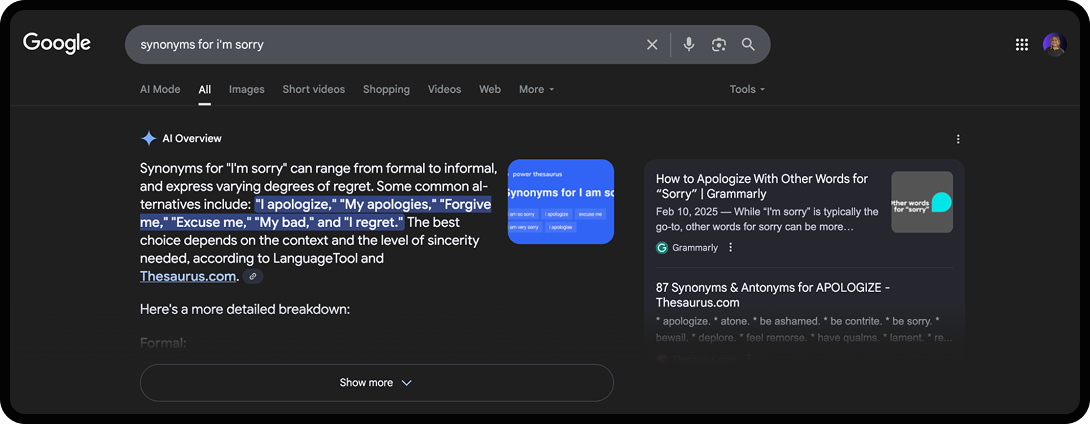
That being said, there are still ways that I use it for content writing. Below are some prompts to get you started.
Content Writing Prompts for ChatGPT
The world of SEO content writing is a bit broader than the previous things we talked about. Bear with me for this mega-library of content prompts:
For Keyword-Driven Topic Creation:
- “Generate 10 blog topic ideas targeting the keyword [keyword] that have an informational search intent.”
- “Suggest related subtopics or long‑tail keywords for a pillar page about [topic].”
For Drafting (& I Emphasize DRAFTING) Content:
- “Write an SEO-friendly blog intro for the topic [topic], targeting the keyword [keyword]. Please include credible sources and external links throughout.”
- For the output of a prompt like this, I would use it as a synthesized research reference. Think “skim, learn, and create”, based on your new knowledge of the topic at hand.
- “Create an outline of H1, H2, and H3 subheadings for a blog post targeting [keyword]. Cover all major questions users might have about [keyword topic].”
- “Suggest relevant FAQs to add at the end of this post based on common user questions.” and paste the post content.
- “Rewrite this paragraph to include the keyword [keyword] naturally and improve clarity.” and paste the paragraph.
- “Write a featured snippet‑style answer (40–60 words) to the question: [question].”
For On-Page Metadata:
- “Write me 3 options for an SEO‑friendly title tag (max 60 characters) and meta description (max 160 characters) for this post.” and paste the post content.
For E.E.A.T. & Authority-Building:
- “Suggest ways to add author expertise or credibility signals to this article.” and paste the article content.
- “Recommend trustworthy external sources or studies I could cite in this post.” and paste the post content.
The best way I can describe the main benefits of using ChatGPT for SEO is that it generates more content than you could ever need, most of it being what us writers would describe as “fluff”. This gives you the opportunity to sift through, find the nuggets of information that you do want to include, and add them to your human-written content in a way that sounds—well, human.
How To Use ChatGPT for PPC
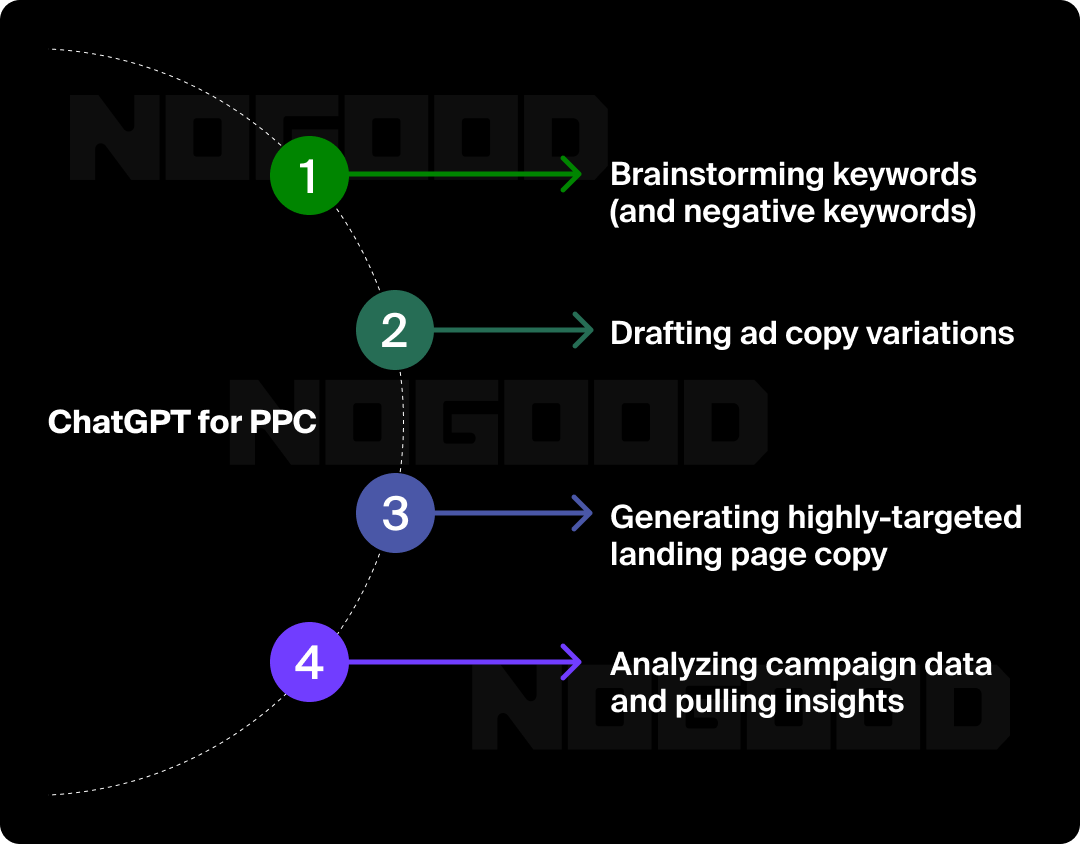
The most common ways for marketers to use ChatGPT for PPC include:
- Brainstorming keywords (and negative keywords)
- Drafting ad copy variations
- Generating highly-targeted landing page copy
- Analyzing campaign data and pulling insights
1. Brainstorming PPC Keywords With ChatGPT
Keyword research for paid ads tends to be done in a very similar way to keyword research for SEO. The main difference is having to align the selected keywords to a budget.
Presumably, if you’re developing a PPC campaign, your keyword research is centered around a persona, pain point, and solution. Use these in your prompts to specify and target the most optimal keywords for your campaign.
PPC Keyword Research Prompts for ChatGPT
For Uncovering PPC Keyword Opportunities:
- “Generate a list of transactional keywords related to [offering] that have strong purchase intent.”
- “Suggest variations and synonyms for the keyword [main keyword] suitable for paid search campaigns.”
- “List keywords combining [main keyword] with price, location, brand, and feature modifiers.”
For Organizing Keywords by Funnel Stage or Intent:
- “Group the below seed keywords by funnel stage (awareness, consideration, decision),” and paste the list.
- “Identify which of the below keywords show high commercial intent vs. purely informational.” and paste the list.
- “Create separate keyword lists for branded, competitor, and generic searches around [offering].”
For Negative Keyword Discovery:
- “Suggest negative keywords I should add to avoid irrelevant clicks for campaigns targeting [main keyword].”
- “Review this list of keywords and flag terms that might attract low‑quality or unrelated traffic.” and paste the keyword list.
For Local or Niche PPC Keyword Targeting:
- “Suggest PPC keywords targeting [offering] in [location], including geo‑modifiers and “near me” terms.”
- “List niche long‑tail keywords people might search for related to [feature or use case].”
2. Drafting PPC Ad Copy Variations With ChatGPT
For a task like creating ad copy variations, it’s important to remember that ChatGPT is a generative pre-trained bot and only has access to its training data. All that is to say, the more people use ChatGPT, the better its responses will become, but until it’s further developed, I recommend sticking to using it as an idea initiator rather than an idea generator.
To translate: similar to only drafting content for SEO using ChatGPT, use it as a way to brainstorm and ideate ad copy variations. Combine the ideas it gives you into an original one, or take one of the variations and inject some humor or brand voice into it. Don’t be a “copy and paste” warrior.
PPC Ad Copy Prompts for ChatGPT
For Generating Multiple Headlines or CTA Variations:
- “Write 10 Google Ads headlines (max 30 characters) and 10 descriptions (max 90 characters) promoting [offering] to [target audience].”
- “Write 10 headline variations emphasizing [benefit] and 10 emphasizing [other benefit].”
- “Create 10 PPC ad copy variations that focus on solving [pain point].”
For Variations in Audience Targeting:
- “Write 5 variations of [platform] ad copy targeting first‑time buyers of [product] and 5 copy variations targeting repeat customers.”
- “Write 5 ad variations for people comparing options for [offering] and 5 variations for people who are ready to buy now.”
- “Suggest 5 headlines addressing budget‑conscious buyers of [offering] and 5 headlines for premium buyers.”
For Adapting to Various PPC Platforms:
- “Rewrite this ad copy to fit Meta Ads’ primary text, headline, and description best practices.”
- “Create a short LinkedIn ad (under 150 characters) targeting B2B buyers of [offering].”
- “Write responsive search ad assets: 10 headlines and 5 descriptions for [topic].”
Notice how none of the above example prompts had anything to do with writing in a certain style (e.g., “write funny, playful ad copy”). You really expected me to recommend that? After everything we’ve been through together? I really thought we were getting somewhere ☹️
3. Writing PPC Landing Page Copy With ChatGPT
Most PPC campaigns require specified landing pages (or changes to be made to existing webpages to align with campaign needs). ChatGPT can help you DRAFT content for new landing pages or RECOMMEND edits for content on existing webpages.
PPC Landing Page Copy Prompts for ChatGPT
For Drafting & Optimizing Landing Page Copy:
- “Write 5 variations of a compelling hero headline and subheadline for a landing page promoting [offering] to [audience]. Focus on [benefit].”
- “Draft body copy explaining why [target audience] should choose [offering], highlighting [top 3 benefits].”
- “Create an FAQ section answering common objections about [offering].”
- “Below is a portion of the current copy on my landing page for [topic]. Give me suggestions for how to align it better with PPC visitors who searched for [keyword].” and paste the text.
- “Make the below copy more concise and action-focused, so it works better for paid traffic.” and paste the copy.
- “Write me 5 CTAs with a focus on urgency for this section of my landing page about [topic].” and paste the text.
- “Make this headline clearer and include the keyword [keyword] for relevance.”
For Audience & Intent Tailoring:
- “Write me 3 variations of [section] of landing page copy for [offering] targeting [audience] searching for [keyword].”
- I like to use ChatGPT to draft content section-by-section; otherwise, it can get off track fairly quickly.
- “Draft copy appealing to high-intent searchers looking for [benefit] [offering].”
4. Analyzing PPC Campaigns With ChatGPT
Though this can theoretically apply to SEO as well, I wanted to include some data analysis prompts in the PPC section since this data tends to be more concrete and dense. That being said, you always have the freedom to get creative! Most of the prompts thus far have been copy-and-paste-ready, but they can always be tailored to match your specific marketing needs.
As a general tip, I recommend pasting in your campaign data as the initial “mini-training” prompt to let ChatGPT know that you’re about to ask it a bunch of questions about the same dataset. I also recommend starting a new chat for things like this, to ensure that you’re working with a “clean slate”.
PPC Campaign Analysis Prompts for ChatGPT
For Overall Performance Analysis:
- “Summarize the key takeaways and trends from this data, as well as what might be causing them.”
- “Based on this data, tell me what’s working well and what needs optimization.”
For Trend & Anomaly Detection:
- “Look at this data split and highlight which campaigns are performing best and worst based on CPA and RoAS.”
- “Identify the ad groups with high spend but low conversions and suggest what might be happening.”
- “Identify which keywords or audiences are driving most of the cost without delivering conversions.”
- “Find unexpected spikes or drops in spend, CTR, or CPA and suggest possible reasons.”
- “Identify seasonal or day-of-week patterns in performance from this data.”
The way I see it, the true power of ChatGPT for PPC is similar to SEO, with the added major benefit of parsing massive datasets and identifying trends that wouldn’t otherwise be visible to the human eye.
Humans typically operate on a singular causation basis (a change in X variable led to a change in Y variable), whereas ChatGPT can spot trends that are caused by three, four, or even five different variables and summarize the impact clearly.
How To Use ChatGPT for Social Media Marketing
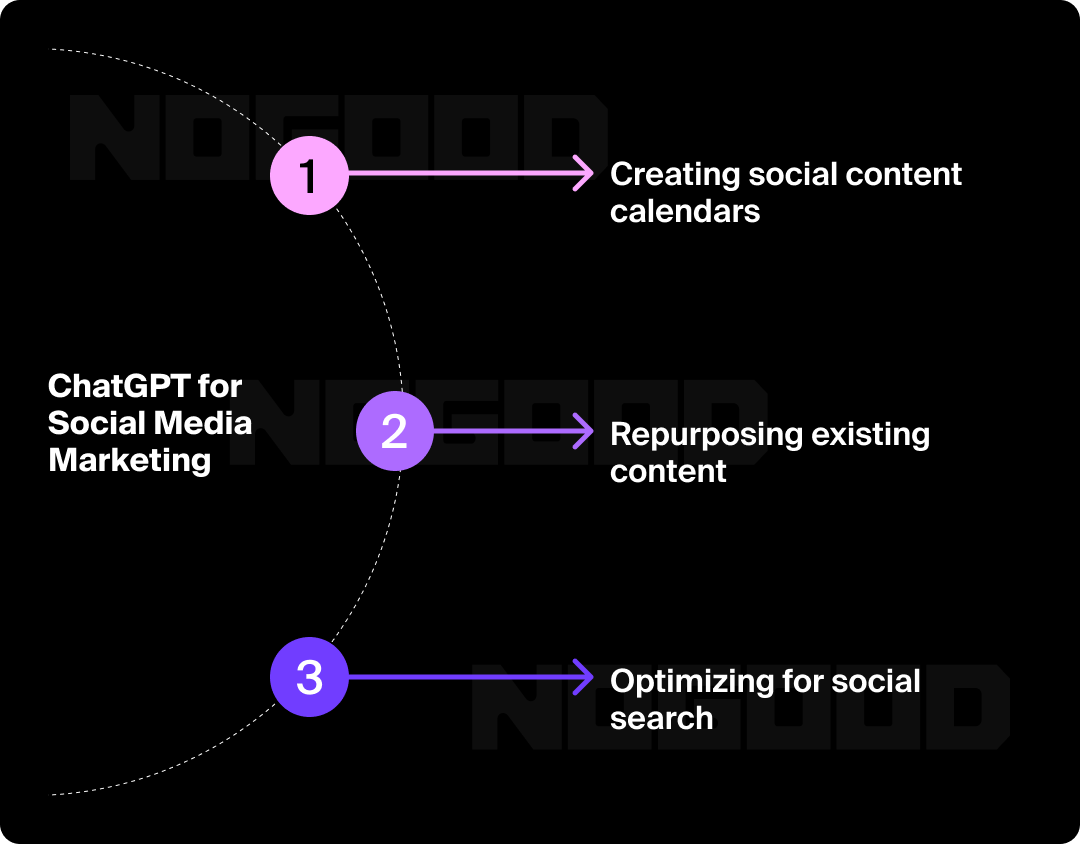
Alright, stay with me here. This is our last channel-specific section before we get to those prompt engineering tips and tricks I promised you. I know you’re growing impatient 😉
Here’s how to use ChatGPT for social media marketing:
- Creating social content calendars
- Repurposing existing content
- Optimizing for social search
1. Creating Social Content Calendars With ChatGPT
I’ll repeat myself again (and spoiler, it won’t be the last time either): ChatGPT should be used to draft content ideas, not copy and paste, or set it and forget it, or any other shortcutting phrase you can think of.
Just like with PPC ads, I find that “mini-training” ChatGPT by providing it with an overview of the offering you’re marketing, the audiences you speak to, your content pillars, and any relevant seasonality or upcoming promotions is the best way to set you up for success.
Social Content Calendar Prompts for ChatGPT
For Creating Calendars & Cadences:
- “Create a 4‑week social media content calendar for [offering] targeting [audience], with 3 posts per week mixing [content pillars] types of content.”
For Aligning Content With Campaign Goals:
- “Create a content calendar supporting our upcoming [event or offering], including teaser posts and follow‑up posts.”
- “Draft a weekly posting plan to [campaign goal] for [offering or promotion].”
- “Brainstorm 10 content ideas for our brand’s social channels focusing on [campaign focus].”
For Frequency & Timing Insights:
- “Build a 3‑posts‑per‑week schedule for [platform], showing which days and times might be best to post.”
- “Suggest an ideal daily posting schedule across [platform or platforms] for a B2C brand in [industry].”
- “Based on what you see as the standard cadence for [industry], build a monthly [platform] cadence for [brand] that includes [post types or topics].”
2. Repurposing Existing Content With ChatGPT
When marketing teams work together efficiently, it’s common for social media to work hand-in-hand with SEO, writers, or video marketers to repurpose content across channels. ChatGPT can help with that!
Content Repurposing Prompts for ChatGPT
For Turning Blogs into Social Posts:
- “Turn the below blog post into 3 LinkedIn posts, each highlighting a different key takeaway.” and paste the blog post content.
- “Summarize this blog into a Twitter thread with 5-7 concise tweets.” and paste the blog content.
- “Create an Instagram carousel outline based on the main points of this article.” and paste the article.
For Creating Multiple Formats From One Source:
- “From the below blog post, generate: a poll question for LinkedIn, a Reel script, and an infographic outline.” and paste the blog post.
- “Draft an Instagram caption, a question sticker for Instagram Stories, and a carousel idea based on the below content.” and paste the content.
For Highlighting Key Points or Stats:
- “Pull 5 attention‑grabbing stats or quotes from this content.” and paste the content.
- “Create 3 discussion questions we could post on LinkedIn based on this article.” and paste the article.
3. Optimizing for Social Search
The rise of social search marks an era where people are using social media as a new kind of search engine. Algorithm and technology advancements have opened the door to things like blue comments on TikTok that answer user queries, eCommerce being increasingly integrated with social media, and the influencer marketing space continuing to develop.
Social media marketers are now tasked with becoming SEOs of their own, aligning content not only with business and campaign goals, but also with platform-specific algorithms. Social search introduces concepts like keyword research, discoverability, and a new set of best practices.
Social Search Optimization Prompts for ChatGPT
For Keyword Research & Content Drafting:
- “Suggest keywords and hashtags people might search for on TikTok when looking for content about [topic].”
- “What are common search phrases users type on Instagram or TikTok to find videos about [topic]?”
- “Rewrite the below Instagram caption to include [keyword] so it’s more discoverable in social search.” and paste the caption.
- “Make the below video script include trending or niche hashtags and keywords for better search reach.” and paste the script.
- “Suggest engaging TikTok video titles that include [keyword].”
For Discoverability:
- “Suggest 10 short video ideas based on what people commonly search for about [offering].”
- “List FAQs people might type in social search around [topic].”
- “Brainstorm questions that users might search on TikTok about [topic].”
- “Suggest hashtags that combine broad reach with niche relevance for this Instagram post.” and provide the post and caption.
For Social Search Best Practices:
- “Explain how using keywords in on-screen text helps TikTok SEO.”
- “Describe why repeating your keyword in captions and spoken audio matters for social search discoverability.”
Since social search is a newer discipline within marketing, it’s important to familiarize yourself with best practices around it before implementing it into your marketing strategy. ChatGPT can be a helpful research tool for this!
ChatGPT Prompt Engineering Tips: How to Use ChatGPT Effectively
If you made it this far, congratulations (and thank you for reading). If you skipped down to this part of the post, I have nothing to say to you except “at least you know what you’re looking for”. Let’s get into some of my favorite prompt engineering tips and tricks for using ChatGPT (for marketing and in general):
1. “Mini-Train” Your Model
I mentioned this throughout the article, but I’ll add it again here for those who really did just skip down to this part (no I’m not salty). To “mini-train” your model, you’ll need to start with a new chat; a clean slate, if you will.
Think of “mini-training” as a giant info dump of every piece of context that ChatGPT might need to be able to give you informed answers to your queries. This can be things like:
- Brand voice guidelines (I’ll stress one last time that I only recommend using ChatGPT for drafting, but this would get you closer to the final brand voice)
- Data from previous campaigns
- Competitor research and analysis
- Growth marketing strategy decks or other presentations with relevant information
I like to tell ChatGPT that I’m about to give it a ton of information, give it said information, and then ask it to confirm that it understands what I’ve given it. From there, your model should be “mini-trained”!
Tip Within a Tip: If you don’t have any of the above information to give ChatGPT, I find that simply asking it, “what can you tell me about [brand]?” typically also does the trick!
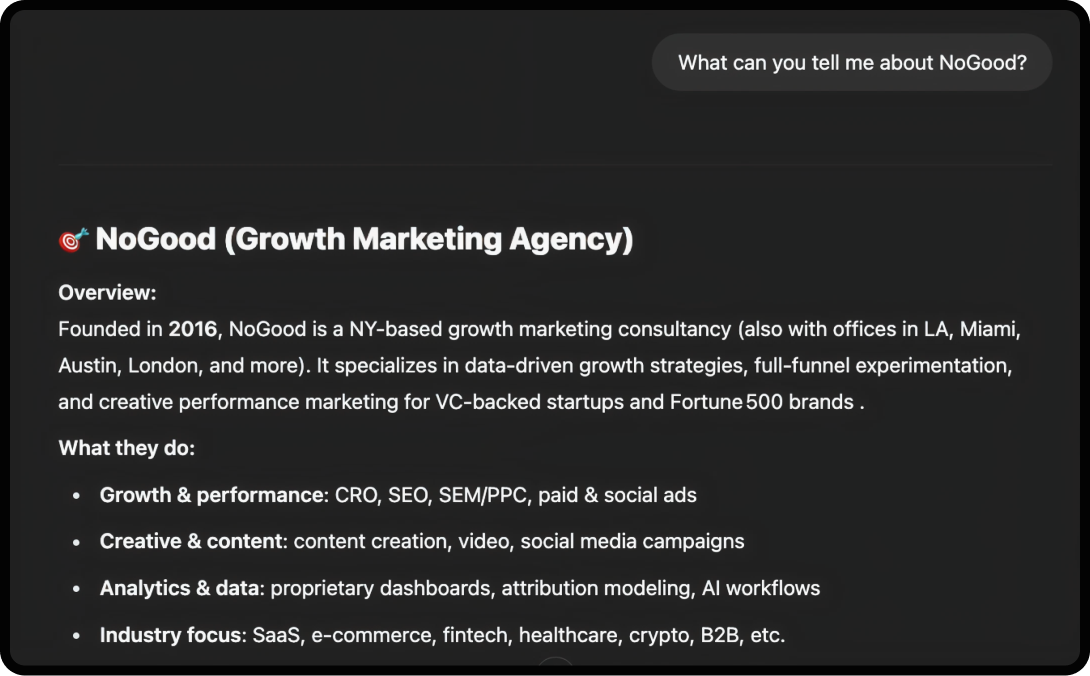
2. Set Up Restrictions & Requirements
On a similar note to “mini-training” your model, you can set and reinforce restrictions and requirements at any point in time. For example, if your brand’s name has changed from what it is in the documentation you’ve provided, you can tell ChatGPT, “Please refer to [old brand name] as [new brand name] from this point onward.” It’s not a perfect system, and ChatGPT might slip up here and there, but hey, that’s why you’re here, isn’t it?
Other examples of restrictions and requirements include:
- Make it under 100 words
- Don’t use the words “innovative” or “fast”
- Walk me through your thought process step-by-step
3. Separate the Query From the Context
This is similar to “mini-training”, but not quite the same. You may have noticed this in the prompt examples provided above—many of them end in “and paste the content” or something to that effect.
I find that starting a request, pasting large amounts of content in the middle of it, and then finishing the request can result in parts of the query being lost in processing. If you need examples of this separation, scroll up to one of the example prompt sections above.
4. Create More Than You Need
There is typically not a noticeable difference in the processing speeds of ChatGPT, whether you ask it for five variations of something or 50. So, why not use that to your advantage?
If you only need three variations of a headline, try asking ChatGPT for 10 of them instead. Maybe number eight will spark something in your creative brain, and you wouldn’t have seen that variation had you asked for specifically the amount you needed.
5. Be Specific, but Don’t Contradict Yourself
The above example prompts are made to be highly customizable and expandable, but remember that ChatGPT is a machine—it interprets everything just as you said it.
If you’re planning on stacking prompts together or creating a megaprompt to use over and over again with slight variations depending on your needs, make sure that the prompt makes sense. That means no contradictions, straightforward requests, and no references to new information that the model doesn’t have yet.
For example, if you ask ChatGPT to analyze a dataset you haven’t provided yet, it’ll likely still give you a response, but with random data that came from who knows where. Not only that, you’ve now also confused your “mini-trained” model, and will likely have to start anew to prevent that “fake” data from making its way into your real data.
6. Ask Again, but in a Different Way
Still not getting the response you’re looking for? Think of a completely different way to ask the question or write the prompt.
Just because AI is more commonplace in the workplace doesn’t mean all critical thinking goes out the window. In fact, I’d argue that it’s more important than ever. You’re essentially critically thinking for two: yourself and ChatGPT.
This is, unfortunately, more of a case-by-case, “you’ll-feel-it-out-eventually” type of prompt engineering tip, but the takeaway is this: knowing what question to ask an AI system is an extremely valuable skill.
Is ChatGPT Replacing Digital Marketing?
If the content of this long-ass post and my periodic words of affirmation weren’t enough to convince you, I’ll give it to you straight: no, ChatGPT is not replacing digital marketing.
The thing that makes marketing work is the human element, the psychology of being, experiencing, and knowing. How are we meant to speak to human pain points, needs, desires, and emotions if we’re taking humanity out of it completely?
ChatGPT and ChatGPT-powered tools still contain flaws that require a human review and editing. All in all, ChatGPT is nowhere near the point where it can simulate the neural networks of a human brain. And with 8 billion unique human brains in the world—all with their own expertise, knowledge sets, cultural experiences, and personalities—we’re not going to get there anytime soon.
To (finally) wrap this up with a nice little bow, all of this is less about being replaced by AI and more about learning to work alongside it. Treat it like a peer: do the upfront 20% of work with data collection and formatting, let ChatGPT do the middle 60%, and swoop back in to apply your humor, industry knowledge, and uniqueness for the last 20%.
I won’t go as far as to say that ChatGPT is your friend, but I will admit that it can be a pretty helpful sidekick.







